
February 2011
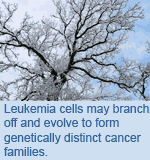 UHN’s Dr. John Dick and collaborators at St. Jude Children’s Research Hospital (Memphis) have found that defective genes and the individual leukemia cells that carry them are organized in a more complex way than previously thought. The findings, published in Nature, challenge the conventional view that cancer progresses as a linear series of genetic events and that all the cells in a tumour share the same genetic abnormalities and growth properties.
UHN’s Dr. John Dick and collaborators at St. Jude Children’s Research Hospital (Memphis) have found that defective genes and the individual leukemia cells that carry them are organized in a more complex way than previously thought. The findings, published in Nature, challenge the conventional view that cancer progresses as a linear series of genetic events and that all the cells in a tumour share the same genetic abnormalities and growth properties.
The research team found that the leukemia cells taken from patients with acute lymphoblastic leukemia (ALL) are actually composed of multiple families of genetically distinct leukemia cells. They discovered that the cells that propagate the disease and potentially survive therapy persist through generations, and even branch off and evolve to form genetically distinct cancer families. Some of these genetic families dominate within the population of cancer cells while other families are very rare, explaining why they had never been previously observed.
Explains Dr. Dick, “By looking at the genetic signatures of the leukemia cells in the different mice we were able to figure out their genetic ancestry and the evolutionary trajectory that that particular leukemia took. We found that if a particular gene family was mutated, the tumours were aggressive when grown in the mice. The patients with the corresponding tumours had poorer survival showing that the human-mouse transplant system could be very useful in predicting patient outcome.”
This insight into genetic diversity has positive implications for cancer treatment. Says Dr. Dick, “Understanding the complexity of cellular relationships and the existence of distinct genetic families of leukemia cells will shed light on why some cells of the cancer are not killed by the therapy and eventually regrow resulting in disease relapse, and help accelerate the development of tailored therapies to wipe out all the unwanted branches in the genetic tree.”
Evolution of human BCR-ABL1 lymphoblastic leukaemia-initiating cells. Notta F, Mullighan CG, Wang JC, Poeppl A, Doulatov S, Phillips LA, Ma J, Minden MD, Downing JR, Dick JE. Nature. 2011 Jan 20; 469 (7330): 362-7. [Pubmed abstract]
This work was supported by funds from the Canadian Institutes of Health Research (CIHR) studentships, the Pew Charitable Trusts, the Stem Cell Network of Canadian National Centres of Excellence, the Canadian Cancer Society and the Terry Fox Foundation, Genome Canada through the Ontario Genomics Institute, Ontario Institute for Cancer Research with funds from the province of Ontario, the Leukemia and Lymphoma Society, the Canadian Institutes of Health Research, a Canada Research Chair, and the American and Lebanese Syrian Associated Charities of St. Jude Children’s Research Hospital. This research was funded in part by the Ontario Ministry of Health and Long Term Care.
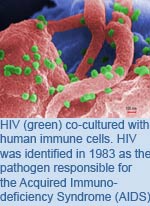 Understanding the factors that have the potential to enhance the immune system’s responses to persistent viruses is essential for designing effective therapies for chronic viral infections like the human immunodeficiency virus (HIV). Recent findings from an OCI team led by Drs. Pamela Ohashi and Tak Mak provide exciting new evidence that sheds light on some of the mechanisms underlying the immune responses to chronic viral infections and implicate the cytokine interleukin-7 (IL-7), a protein molecule that is critical for immune system development and regulation, as a major player and potential new therapeutic option.
Understanding the factors that have the potential to enhance the immune system’s responses to persistent viruses is essential for designing effective therapies for chronic viral infections like the human immunodeficiency virus (HIV). Recent findings from an OCI team led by Drs. Pamela Ohashi and Tak Mak provide exciting new evidence that sheds light on some of the mechanisms underlying the immune responses to chronic viral infections and implicate the cytokine interleukin-7 (IL-7), a protein molecule that is critical for immune system development and regulation, as a major player and potential new therapeutic option.
The team, with collaborators from Australia, France, Germany and USA, used an experimental mouse model of chronic infection which mimics the massive virus levels that are associated with HIV infection in humans. With IL-7 treatment, these mice showed a significant increase in the magnitude of the immune response that was linked to a substantial enhancement of T cell (immune cells) numbers and more effective clearance of the virus from the spleen and liver.
“The mice treated with IL-7 did not present the typical pathologies associated with a major immune response to virus infection, like hepatitis.” comments Dr. Ohashi. “These findings provide great insight into the mechanisms underlying chronic viral infections and certainly suggest IL-7 therapy as a potentially powerful therapeutic option for treating infections like HIV.”
IL-7 Engages Multiple Mechanisms to Overcome Chronic Viral Infection and Limit Organ Pathology.
Pellegrini M, Calzascia T, Toe JG, Preston SP, Lin AE, Elford AR, Shahinian A, Lang PA, Lang KS, Morre M, Assouline B, Lahl K, Sparwasser T, Tedder TF, Paik JH, Depinho RA, Basta S, Ohashi PS, Mak TW. Cell. 2011 Feb 18;144(4):601-13. [Pubmed abstract]
This work was supported by the Canadian Institutes of Health Research, the Terry Fox Cancer Foundation National Cancer Institute of Canada, the Boninchi Foundation, the Irvington Institute and the Cancer Research Institute (US), the Australian National Health and Medical Research Council, the Natural Sciences and Engineering Research Council, the Canada Research Chairs Program, and the Ministry of Health and Long Term Care.
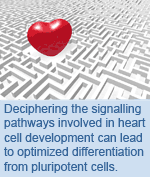 A recent study, led by McEwen Centre for Regenerative Medicine Director Dr. Gordon Keller in collaboration with Dr. James Ellis (Hospital for Sick Children) and published in the journal Cell Stem Cell, demonstrates the delicate balance of factors involved in producing heart cells from different types of embryonic and induced pluripotent stem cells.
A recent study, led by McEwen Centre for Regenerative Medicine Director Dr. Gordon Keller in collaboration with Dr. James Ellis (Hospital for Sick Children) and published in the journal Cell Stem Cell, demonstrates the delicate balance of factors involved in producing heart cells from different types of embryonic and induced pluripotent stem cells.
The team found that by manipulating key signalling pathways in pluripotent cells they are able to induce the differentiation of heart cell progenitors, as determined through the expression of two key markers: Flk-1/KDR and PDGRF-alpha (F+P+ cells). Interestingly, different pluripotent cell lines (for example, induced pluripotent stem cells versus embryonic stem cells) require a unique balance between the activation and inhibition of these signalling pathways for optimal development of heart cells. With the right combination they can obtain populations containing greater than 60% F+P+ progenitors that give rise to highly enriched populations of heart cells.
This research highlights the importance of determining the fundamental steps involved during the differentiation of cardiac cells. Says Dr. Keller, “The ability to produce a population of heart cells from pluripotent cells provides immense opportunities to develop novel therapies for cardiovascular disease, and to study the development of normal and diseased heart tissue.”
Stage-Specific Optimization of Activin/Nodal and BMP Signaling Promotes Cardiac Differentiation of Mouse and Human Pluripotent Stem Cell Lines. Kattman SJ, Witty AD, Gagliardi M, Dubois NC, Niapour M, Hotta A, Ellis J, Keller G. Cell Stem Cell. 2011 Feb 4;8(2):228-40. [Pubmed abstract]
This work was supported by grants from the National Institutes of Health and the Canadian Institutes of Health Research.
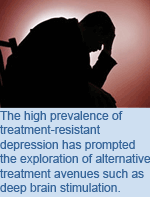 At least 30 percent of patients with depression are resistant to treatment with antidepressants. Deep brain stimulation (DBS), a potential therapy alternative for treatment-resistant depression, involves placement of electrodes at specific sites in the brain to deliver continuous stimulation from an implanted generator. A study led by TWRI’s Dr. Andres Lozano and UHN’s Psychiatrist-in-Chief, Dr. Sidney Kennedy, confirms that DBS provides benefits in long-term treatment-resistant depression for as long as six years.
At least 30 percent of patients with depression are resistant to treatment with antidepressants. Deep brain stimulation (DBS), a potential therapy alternative for treatment-resistant depression, involves placement of electrodes at specific sites in the brain to deliver continuous stimulation from an implanted generator. A study led by TWRI’s Dr. Andres Lozano and UHN’s Psychiatrist-in-Chief, Dr. Sidney Kennedy, confirms that DBS provides benefits in long-term treatment-resistant depression for as long as six years.
After an initial 12-month study of DBS, Dr. Lozano’s team assessed response rates to DBS in a group of 20 patients annually and at a last follow-up visit. The average response rates were 62.5%, 46.2% and 75% at years 1, 2 and 3, and 64.3% at the last follow-up visit. Progressive improvements in physical health and social functioning were observed up to the last follow-up visit.
Explains Dr. Lozano, “These data suggest that in the long-term, DBS remains a safe and effective therapy for treatment-resistant depression. However, additional trials with larger samples are needed to confirm these findings.”
Deep Brain Stimulation for Treatment-Resistant Depression: Follow-Up After 3 to 6 Years. Kennedy SH, Giacobbe P, Rizvi SJ, Placenza FM, Nishikawa Y, Mayberg HS, Lozano AM. American Journal of Psychiatry. 2011 Feb 1. [Pubmed abstract].
Research supported in part by the Department of Psychiatry at University Health Network.
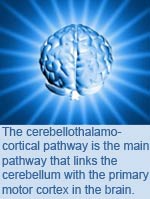 New findings from Drs. Robert Chen and Anthony Lang and postdoctoral fellow Dr. Zhen Ni at TWRI have shed new light on our understanding of the role of the cerebellothalamocortical (CTC) pathway in Parkinson disease (PD).
New findings from Drs. Robert Chen and Anthony Lang and postdoctoral fellow Dr. Zhen Ni at TWRI have shed new light on our understanding of the role of the cerebellothalamocortical (CTC) pathway in Parkinson disease (PD).
The CTC pathway can be assessed by stimulating the cerebellum using a technique called transcranial magnetic stimulation (TMS). Drs. Chen and Lang and colleagues performed TMS studies to assess whether stimulation of the cerebellum or of the primary motor cortex (M1) is involved in the generation or transmission of tremors in PD.
“The present study demonstrates deficits in cerebellar function in PD with decreased excitability of the CTC pathway,” notes Dr. Chen. “Our findings show that resting and postural tremors in PD are mediated by different neuronal pathways, and that the CTC pathway is involved in the generation or transmission of postural tremor.” This is the first physiological demonstration of abnormality of the cerebellum in PD.
Involvement of the cerebellothalamocortical pathway in Parkinson disease.Ni Z, Pinto AD, Lang AE, Chen R. Annals of Neurology. 2010 Dec;68(6):816-24. [Pubmed abstract].
Research supported by the Canadian Institutes of Health Research.
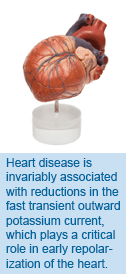 A recent study performed by TGRI’s Dr. Peter Backx provides exciting new insight into factors involved in the regulation of electrical currents in the heart in cardiac disease.
A recent study performed by TGRI’s Dr. Peter Backx provides exciting new insight into factors involved in the regulation of electrical currents in the heart in cardiac disease.
The fast transient outward potassium current (I-to,f) serves unique roles in the heart by promoting both proper electrical activation and maintaining mechanical function. Despite its importance, little is known about the mechanisms controlling the profound reduction in I-to,f that invariably occur in heart disease. Building on previous studies establishing that I-to,f is created by two channel protein subunits (Kv4.2, Kv4.3) along with an auxilliary subunit (KChIP2), Dr. Backx and his colleagues have now shown that the transcription factor, NF-kappaB, mediates I-to,f reductions in heart disease conditions by repressing KChIP2.
"Since NF-kappaB is a classical factor in mediating inflammation in tissues, our results identify a novel mechanism linking changes in I-to,f (via KChIP2) to the alterations in inflammatory signaling which is a critical feature of cardiac hypertrophy and heart failure” notes Dr. Backx. “Clearly, additional studies are needed to determine if modulation of NF-kappaB and inflammation in the heart will be effective in treating the harmful electrical remodeling and contractile changes occurring in heart disease.”
Nuclear Factor kappa-B Downregulates the Transient Outward Potassium Current Ito,f Through Control of KChIP2 Expression. Panama BK, Latour-Villamil D, Farman GP, Dongling Z, Bolz S-S, Kirshenbaum LA, Backx PH. Circulation Research. 2010 Jan 20. [Pubmed abstract].
Research supported by the Heart and Stroke Foundation of Ontario Canada and the Canadian Institutes of Health Research.

![]()
 On January 20, 2011, Dr. Ernest "Bun" McCulloch passed away. It is with great sadness that we share this news and salute the memory of this visionary haematologist and scientist. Dr. McCulloch was an esteemed Senior Scientist and former Head of Biology at the Ontario Cancer Institute/Princess Margaret Hospital and a University Professor Emeritus at the University of Toronto. This pioneer of stem cell science, along with Dr. James Till, is renowned for establishing an entire field of study with the 1961 discovery of blood-forming stem cells. Click here for a more detailed biographical sketch of Dr. McCulloch.
On January 20, 2011, Dr. Ernest "Bun" McCulloch passed away. It is with great sadness that we share this news and salute the memory of this visionary haematologist and scientist. Dr. McCulloch was an esteemed Senior Scientist and former Head of Biology at the Ontario Cancer Institute/Princess Margaret Hospital and a University Professor Emeritus at the University of Toronto. This pioneer of stem cell science, along with Dr. James Till, is renowned for establishing an entire field of study with the 1961 discovery of blood-forming stem cells. Click here for a more detailed biographical sketch of Dr. McCulloch.We will miss you Dr. McCulloch.
 UHN is pleased to announce that Dr. Mansoor Husain, Senior Scientist at TGRI, has accepted the position of TGRI Director, beginning in May 2011.
UHN is pleased to announce that Dr. Mansoor Husain, Senior Scientist at TGRI, has accepted the position of TGRI Director, beginning in May 2011.
As a specialist in cardiovascular disease and nuclear cardiology, Dr. Husain brings outstanding clinical and research credentials to the role. He is currently Director of Research at the Peter Munk Cardiac Centre at UHN and Director of the Heart & Stroke/Richard Lewar Centre of Excellence at the University of Toronto. In addition, he is affiliated with the McEwen Centre for Regenerative Medicine and recently served as President of the Canadian Hypertension Society.
Dr. Husain received his MD degree from the Univeristy of Alberta, and subsequently trained at UHN, St. Michael's Hosptial, MIT and Harvard University. His research focuses on molecular regulation of vascular smooth muscle cell proliferation and differentiation, cardiovascular tissue-specific transgene regulation for studies of molecular pathophysiology, and collaborative studies of genetic and experimental models of cardiovascular disease. His program also involves research in clinical and experimental cardiovascular imaging and trials in acute cardiac care.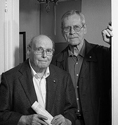 On February 1, 2011, UHN paid homage to the "fathers of stem cell science", OCI researchers Dr. James Till and the late Dr. Ernest McCulloch, marking the 50th anniversary of the publication of their groundbreaking discovery of blood-forming stem cells. Also on this occasion, UHN honoured the memory of Dr. McCulloch, who passed away on January 20, 2011.
On February 1, 2011, UHN paid homage to the "fathers of stem cell science", OCI researchers Dr. James Till and the late Dr. Ernest McCulloch, marking the 50th anniversary of the publication of their groundbreaking discovery of blood-forming stem cells. Also on this occasion, UHN honoured the memory of Dr. McCulloch, who passed away on January 20, 2011.
The event included tributes to the two esteemed researchers and their exceptional research discoveries through speeches and video, which you can view here.
 UHN congratulates Dr. Anthony Lang, Senior Scientist at the Toronto Western Research Institute, Director of the Movement Disorders Research Centre at TWH, and the Jack Clark Chair for Parkinson's Disease Research at the University of Toronto's Centre for Research in Neurodegenerative Diseases, for being appointed as an Officer of the Order of Canada. Dr. Lang, a world leader in Parkinson's disease research, is recognized with this honour for his contributions to the field of movement disorders, notably for advancing therapeutics for patients with Parkinson's disease.
UHN congratulates Dr. Anthony Lang, Senior Scientist at the Toronto Western Research Institute, Director of the Movement Disorders Research Centre at TWH, and the Jack Clark Chair for Parkinson's Disease Research at the University of Toronto's Centre for Research in Neurodegenerative Diseases, for being appointed as an Officer of the Order of Canada. Dr. Lang, a world leader in Parkinson's disease research, is recognized with this honour for his contributions to the field of movement disorders, notably for advancing therapeutics for patients with Parkinson's disease.
Appointees to the Order of Canada were announced by the Governor General of Canada, the Right Honourable David Johnston on Thursday December 30, 2010. The Order of Canada, one of our country's highest civilian honours, was established in 1967 to recognize a lifetime of outstanding achievement, dedication to community and service to the nation.
Congratulations Dr. Lang! Dr. Gary Levy, Medical Director of the TGH Multi-Orgran Transplant Program, Director of the University of Toronto Transplantation Institute and Senior Scientist at TGRI, has been inducted as a Fellow of the American Gastroenterological Assocation (AGA). Dr. Levy was selected for this prestigious award in recognition of his exceptional research program and continued commitment to the field of gastroenterology.
Dr. Gary Levy, Medical Director of the TGH Multi-Orgran Transplant Program, Director of the University of Toronto Transplantation Institute and Senior Scientist at TGRI, has been inducted as a Fellow of the American Gastroenterological Assocation (AGA). Dr. Levy was selected for this prestigious award in recognition of his exceptional research program and continued commitment to the field of gastroenterology.
Founded in 1897, the AGA is the United States' oldest medical society dedicated to disorders of the gastrointestinal tract and includes members from around the world. The AGA Fellows Program honours superior professional achievement in clinical private or academic practice and in basic or clinical research.
Congratulations, Dr. Levy!
Feedback/To Unsubscribe
Net Results EXPRESS is brought to you by UHN Research Communications. We hope you have enjoyed receiving this message. If you have any feedback, or if you wish to unsubscribe, please email www@uhnresearch.ca.
To access archived issues of Net Results EXPRESS, visit uhnresearch.ca/news/netresultsexpress
Some images adapted from the image archives of stock.xchng.ca.